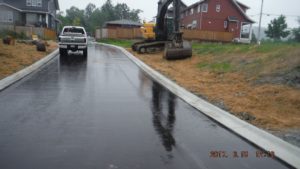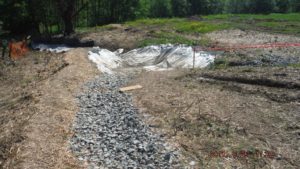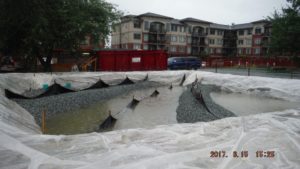Erosion and Sediment Control Monitoring
Many local governments require construction developments to have an Erosion and Sediment Control (ESC) plan and regular monitoring in order to limit the amount of sediment being discharged (and in some cases the pH of the discharge) into fish bearing streams from rain water runoff.
Fine grained silt and clay soils get picked up by rainwater runoff from construction sites and can be discharged directly into salmon bearing streams if left untreated. These sediments significantly reduce the water quality of streams, can accumulate in fish gills, and in some cases can directly result in the death of aquatic life. For this reason, local governments have stringent regulations on the maximum sediment concentration (or turbidity) that is allowable from a site.
Phoenix has many years of experience in designing and monitoring site specific ESC plans for single and multi family residential, commercial and industrial developments. Additionally, Phoenix’s ESC plan designers have obtained their Certified Erosion and Sediment Control Lead (BC-CESCL) certifications. The ESC services which Phoenix provides include:
- Design of a site specific ESC plan
- Regular site visits and measurements of discharge turbidity
- Recommendations to the contractor on possible improvements
- Regular reports to the local government demonstrating the development’s compliance with local bylaws
Most ESC plans are designed around the following principles:
Minimize the amount of turbid runoff which is produced

The best and most cost effective way to limit the discharge of turbid runoff into a stream is minimize production of turbid runoff. This can be done by:
- Covering exposed fine grained soils with polyethylene sheeting or dense straw
- Constructing crushed rock site access pads for vehicles and machinery to limit tracking of sediments onto roads
- Sweeping to maintain a clean, sediment free road
Contain and collect on site runoff
In order to ensure that all runoff is treated before being discharged, it is essential that the runoff be contained to the site and directed to a collection point. This can be done using:

- Bioswales or ditches to convey runoff
- Grading of slopes toward the collection point
- Silt fence to prevent sediment from being transported off site
Treat collected runoff before discharging to environment
In order to ensure that all runoff from the site has sediment levels below the local regulations, the runoff is often treated before being discharged into the environment. This can be done using different technologies, and often depends on the local bylaws. Typical treatment technologies include:

- Sediment settling ponds to give sediment time to settle out before water is discharged. These often incorporate baffles to further increase retention time.
- Treatment systems which often use a combination of settling tanks and filters to remove sediments. Treatment systems can also be used to treat for high pH.
